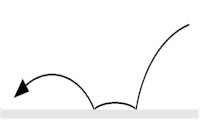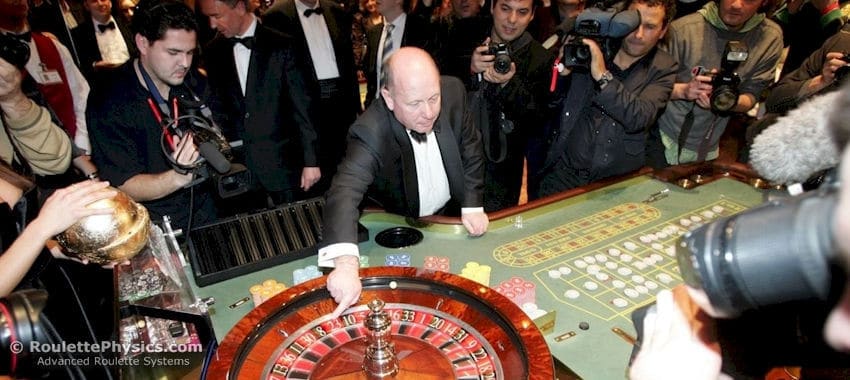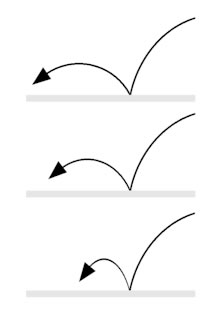In this issue I’ll explain in plain English some of the principles that make it possible to accurately predict where the ball will land, even before the wheel is spun. Of course I need to keep the major parts of my system secret. And besides to succeed with my system you don’t need to know “everything” – you only need to use the automated software that does all analysis for you. Additionally, even if I did release all secrets, most people wouldn’t understand them anyway, and the people who would understand them may either be casinos who that use it against players, or people that claim they made the discoveries themselves.
So I will give examples everyone can relate to. The purpose of this is so you can understand what many people perceive as random is actually predictable. Still you may find some of the information difficult to fully digest as it involves some primordial physics of the universe, so you need a deeper understanding for some of it to make sense. Keep in mind I’ve been studying this for 20 years so I don’t expect everyone to grasp it.
The Rubber Ball Experiment

Google “ball unpredictable bounce”, then check the Images. You’ll many oddly shaped balls like the one left. This particular ball is for dogs. It bounces erratically and is fun for dogs to chase.
Now let’s say you had no idea what the ball looked like, and your aim was to predict where it will bounce. All you knew was the successive trajectories and distances of bounces. To simplify, you knew nothing about the ball except “how it bounced”.
To an ignorant observer, the bounce would be perceived as plain unpredictable and “random”, so it wouldn’t be possible to know with any degrees of certainly where the ball will bounce.
But someone who properly studied the ball’s bounce (let’s call them the “keen observer”) would notice there are particular patterns of bouncing that occur. For example, they will notice sometimes the ball bounces on a “reflective trajectory” as if the ball were perfectly “round”. But sometimes the ball does a kind of “double bounce” right at the ground before bouncing up higher again. Sometimes there’s just a single bounce, but the rebound is not “mirrored” which indicates the ball is not perfectly round.
After a few bounces, the ignorant observer will have given up and assumed that predicting the bounce was simply impossible. But the keen observer will notice that although they can’t yet predict exactly how the ball will bounce, there are still consistencies in how the ball behaves, and this helps us prediction where the ball will bounce next. Specifically based on previous bounces, we may be able to predict where the ball is LEAST likely to bounce, and where the ball is MOST likely to bounce.
For example, we may notice when the ball hits the ground with great force, there is never more than “two close successive bounces”. But if the ball does a bit of a roll, it kind of “tumbles” along in reasonably predictable way . . . and there are certain predictable trajectories the ball will or will not take, so there is actually ample predictable behavior we didn’t initially see. Read the last sentence again and think about it.
So now the keen observer is getting an idea of the general shape of the ball, and this offers clues for predicting the bounce. Below are some diagrams to help you visualize what the “keen observer” notices. To keep things simple, we’ll draw the ball as a 2 dimensional cross-section:
 |
Modelling the Relationships
The point of the above example is so you understand what may first seem random is not random at all. In the case of the rubber ball, clearly the more bounces we observe, the more data we have to create a “model” of the ball.
Now imagine a computer program that took into account the trajectory of a falling object due to gravity (this is known to science), and the angles between each ball trajectory after bouncing. Every bounce we observed gave us a better idea of the ball’s shape and features . . . and once we have modelled the ball, we can better predict its behavior.
In the rubber ball example, we assumed the ground was perfectly flat and made from a uniformed and hard material. Nevertheless, essentially we just modelled a simple relationship between the ball and ground.
My roulette system applies the same principles to the roulette ball and wheel. Certainly the relationship between a roulette wheel and ball is much more complex than in the rubber ball example, but the principles are exactly the same (there are many more “variables” than just the wheel and ball but I’ll explain that later). Understand that when I say “relationship”, I’m talking about correlation. I’m talking about how one thing affects and interacts with the other. And once such relationships are modelled, you can use one thing to predict the other. It is an illusion that variation of ball and wheel speeds is critical, because the wheel and ball will almost always be released at speeds within the same speed ranges. I cannot over-emphasise how paramount this is to understand.
Energy interactions
Firstly, as is now evident from modern research of our universe, we are beginning to discover the universe is not just slightly different to how we “perceive” it to be . . . it is vastly different to how we perceive it. A simplistic way to explain it is “everything is energy”. Yes most of us know Einstein’s equation of E=MC^2 that indicates matter and energy are the same thing. Yet we don’t hold an everyday object and think of it for what it actually is. To us, a rock is just a rock. But in reality it is a sea of vibrating and living energy in constant motion.
Now for something you may find hard to swallow . . . your perception that ball and rotor speeds are mainly what contributes to where the ball lands is somewhat of an illusion. Yes these variables are part of it, but there is so much more to it. So WHY does the ball really land where it does? . . .
The ball lands where it does because of the relationship between the wheel, the ball, and other variables. And regardless of how you perceive it, the wheel speed, wheel itself, the ball, the dealer, the air around it all . . . it is still ultimately just an interaction between energy that occurs within known variables including what you perceive to be “random” ball and wheel speed ranges.
Simple and elegant, just like our universe at its core. Perhaps even mundane if not fully understood. And yes, it is “cause and effect” as I mentioned in earlier issues. But now perhaps you have a deeper understanding of what I mean by it.
Applying the knowledge to beat roulette
Again regardless of your perception, the winning number is the result of nothing more than an energy interaction. Where mostl people see it as ball and wheel speeds, I see it as an energy interaction. And I have found a way to model energy interactions that contribute to the winning number in roulette.
In plain English, I have developed software that models the relationship between variables, and other variables that contribute to where the ball will land. This modelling is capable of predicting where the ball will land . . . of course not with perfect accuracy, but with more than enough accuracy to overcome the casinos “unfair payouts” (house edge). There is no “fantasy” science about it. It uses real and pure physics, just like any other legitimate method like visual ballistics, but my system is far more advanced.
Over the years, people with no understanding of my methods have said my methods sound like “voodoo”. Such comments come from ignorant people that really have no idea what they’re saying. These kind of people may understand basic methods like visual ballistics, but do not understand the underlying variables that determine the winning number. When people have their beliefs challenged, they tend to act defensively. It is absolutely true that “All truth passes through three stages. First, it is ridiculed. Second, it is violently opposed. Third, it is accepted as being self-evident.”
This is relevant because currently, most casinos only take steps to protect themselves against old and now accepted methods for beating roulette. Of course the older methods still have some merit, but not like they did 30 years ago. Now remember that casinos previously believed roulette was unbeatable, but now they know better. But they don’t bother to protect themselves against methods such as my full system, because most don’t YET fully understand how or why roulette is still being beaten.
So if you want to make your money before the casinos are fully aware of my methods, you need to take advantage of them before the change the game. While real wheels exist, my system will likely always be effective. But now an increasing number of casinos are replacing their wheel wheels with RNG roulette terminals where players bet against a fake roulette wheel animation. This means there is no real wheel. It is a slot machine that cannot be beaten. To take advantage of my full system while real wheels are still common, visit www.roulettephysics.com/purchase/
To get the best free roulette systems that really work, see the top 5 proven roulette systems and the video series below. It's the best 100% free information for winning roulette you'll find. It's written by professionals who are really earning a living from roulette. |




